With the first bite of winter on the summits, we thought it was worth taking a look at how to get out safely in the mountains through the coming months.
The world can be roughly divided into two kinds of people; those that hang up their fell shoes when the hills receive their first dusting of snow and those that spend most of the Autumn sharpening their crampons and checking the forecast for anything resembling a weather warning.
We’re here to take you from the former to the latter.
With a little bit of planning, the right equipment and most importantly, training; the winter hills and fells can become your playground and allow you to train all year round.
First and foremost, any decision about going out in the hills in winter needs to be informed by a few key things, everything else then follows from these:
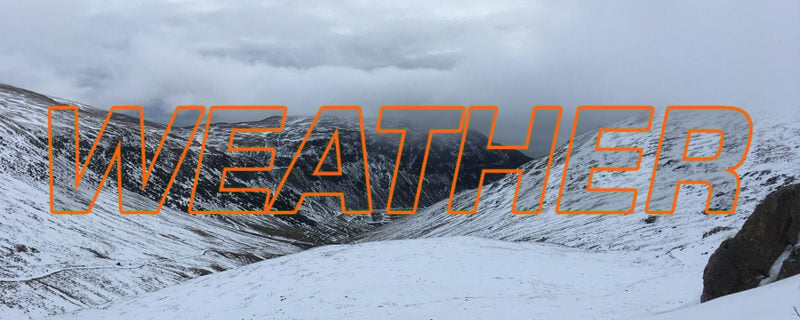
It sounds simple, but it cannot be stated enough that the root of all else in the mountains comes from the conditions. Check the forecast, check a different forecast and another, now check the first one again to see if it’s changed. Look at the weather in the build-up to your day out. Heavy snowfall in the week leading up to it, heavy rain, hard freezes. All these will go on to inform the later stages of your planning.
There are a few weather sites and apps that we regularly use here at OMM, these are updated regularly and by those that know what they are doing.
MWIS (Mountain Weather Information Service)
This gives detailed forecasts for the main mountain areas of the UK with details specifically relevant to runners, walkers and climbers such as “Effect of wind on me” and “Chances of cloud free summits”. The detailed forecasts and videos are a great tool for planning where to head and make the most of your winter run.
Mountain-Forecast
This is another very detailed forecast with weather maps and a choice of heights to look at. So you can zero in on the mountain or area of choice, then check out the conditions at its base, middle and top. The information on windspeed and direction is particularly useful when looking at where accumulations of snow or wind slab are likely.
YR – Norwegian Meteorlogical Institute
This website and very nifty app gives accurate and easily understandable forecasts for the UK and rest of the world. It is used by sailors and shipping companies as well as us on dry land. Whilst it is not specifically geared towards the mountains, it is regularly updated and easy to understand with enough detail to make informed decisions about which direction to head in. The app in particular is well worth having.
SAIS – Scottish Avalanche Information Service
For those heading to the Highlands in winter, this is an invaluable service used by winter mountaineers, rescue teams and winter hill goers. Detailed, reliable and thorough; these forecasts are an important part of any route planning as avalanche poses a very real risk in the Scottish mountains. There are several sites in the rest of the UK that are also prone to avalanche, it is worth looking into a winter skills or avalanche awareness course if you plan on heading to these sorts of areas.
Winter running covers a large range of conditions. There are days where you’re headed out for your local low–level loop, in 10oC and drizzle where you might look a little odd with ice axe and balaclava (top tip, don’t do it, the police don’t find it funny). And there are days where you’re headed for some winter Munro-bagging over large tracts of remote mountain in –15oC windchill, spindrift and 60mph winds where a pair of postman crampons and slightly thicker Buff might be deemed slightly underdressed.
Snow: The big one. This is what turns our hills from brown lumps to alpine wonderlands. Everything looks better in the snow. But it shouldn’t be underestimated. At the very least it is going to slow you down. This is one of the biggest factors in people overshooting their estimated finish times and being out for longer than expected. Not necessarily an issue but if you factor in fatigue and deteriorating conditions, it can be very serious.
Many people are unaware of the avalanche risk present in the UK’s hills, associating them instead with the Alps and bigger mountains. But avalanche is a very real danger, even in the modest Lake District. Get yourself booked on a winter skills course and learn how to read the slopes for danger signs. Better yet, plan your route to avoid any potential danger spots. Find out more here
Snow depth and condition are a major factor in how your day is going to go. A powdery dusting just makes everything magical, deep slush is going to be hell and your feet are going to get wet and cold.
Rain: Let’s be honest, winter in the UK isn’t all rainbows and puppy dogs; for the majority of us, the majority of the time it is just going to mean a slightly colder brand of rain for 4 months. But once again, don’t underestimate the impact this can have. Getting soaked through and then being exposed to cold winds can rapidly reduce your core temperature, far quicker than if you were out in much colder but drier conditions.
Fog/Mist/Cloud: As with rain, the clag is definitely a defining factor in most people’s winter running. If you are heading into the clouds, even on fairly well-defined paths, you are likely to need to stop and take a bearing and to do so more than once. If the ground is also then covered in snow, this can make route finding a challenge and will, again, slow you down.
Wind: On a recent foray into the Far Eastern Fells of the Lake District, I had the unique experience of being blown backwards down a section of frozen path in the face of a 65mph headwind. Wind can not only slow you down but significantly tire you. So, when checking the forecast; look at the windspeeds and get to know what those speeds feel like, then start to learn what effect that will have on your running. There is then the problem of windchill; even on days when the ambient temperature is above freezing, windchill can plunge it to well below. Think about your layering and how to cover as much skin as possible.
Terrain: We are blessed in the UK with a wide variety of landscapes to play in. From low level plains to rolling moors, broad mountain slopes and craggy outcrops. Ice, rain, snow and wind can alter how we move in these spaces and you will need to think how a coating of hoare frost or an extra metre of snow is going to transform your chosen route. Not to mention potentially disguising landmarks, covering paths and generally getting in the way.
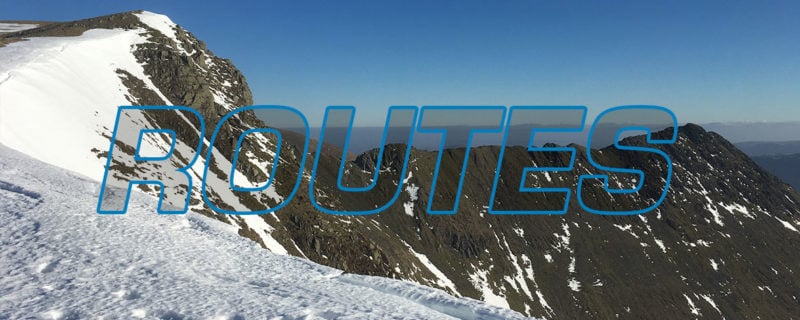
Tailor the route to suit your abilities. If you’re confident on steep snow and have the skills to move safely over frozen terrain, then by all means plan a route that includes this. But if this is your first foray into winter mountains or if you are unsure of how the conditions may affect the route choice, be conservative.
All of the above, if nothing else, will certainly slow you down. Factor this into your planning and route choice to avoid getting caught out. Far better to plan a shorter route with plenty of escape options than to overstretch yourself and realise you’ve run out of jelly beans two hours from the car.
Below we have outlined three excellent winter running routes, each has its own challenges but give an example of the different levels of winter running that are possible.
Obviously there are numerous options and we all have our favourites but these offer a good contrast of what can be done.
PEAK DISTRICT
9 Edges Route
High Moorland
21mi
A linear traverse of the gritstone edges of the Peak is a great day out at any time of year but can be particularly rewarding in winter when the idyllic valleys receive a heft of snow and the tops become more like plateaus of tundra. This route takes in: Derwent, Stanage, Burbage Upper & Lower, Froggat, Curbar, Baslow, Gardoms and Birchens.
Expect soft, deep snow in drifts by boundary walls low down in the valley and wind scoured tops with hard frozen paths and bog. With lots of time spent on the exposed edges, you can expect to be buffeted by high winds and be running over frozen ground.
LAKE DISTRICT
Fairfield Horseshoe
High Fell
10mi
A popular favourite all year round and thanks to the lack of any serious technical difficulties, it can make a great introduction to winter mountain running.
Lower level slush on well trafficed paths leads to snow covered slopes with some steeper sections. The snow covering masks the normally obvious path but as a popular route, the way is usually pretty obvious. The broad summit of Fairfield catches high winds and can be tricky to get the right line off in whiteout conditions.
SNOWDONIA
Snowdon Horseshoe
High Level / Technical
7mi
This is a high level and sustained route of some considerable technical difficulty that challenges summer walkers or runners and blurs the line between running and winter mountaineering when it is covered in snow and ice.
Sustained exposure and hands-on sections of scrambling require a steady head and experience of crampon and even ice axe use. This is only to be undertaken by the most experienced of winter runners as a mistake could prove terminal.
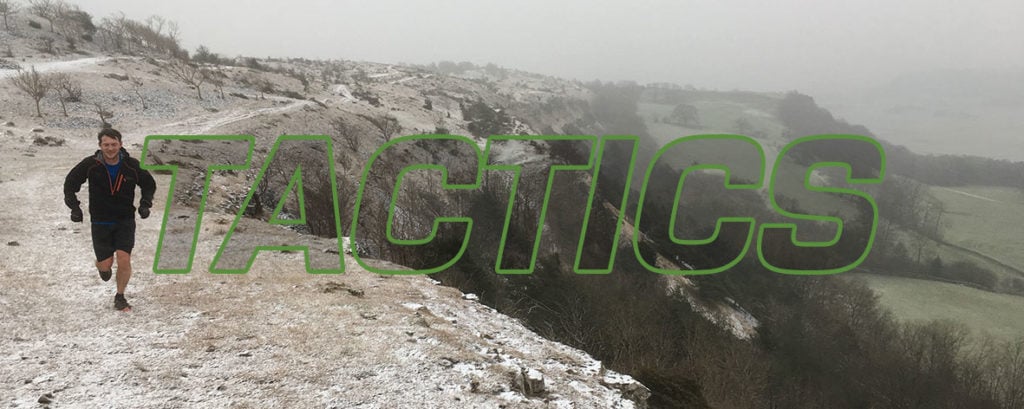
Here are a few of our top tips, gleaned over the years of wading through slush and generally falling over in an undignified manner in the mountains:
- You are likely to be carrying a larger and heavier pack than in summer, thanks to all these extra cheese butties and clothing. Once again, you need to consider this when planning your route. How will that 1 in 5 slope feel when weighed down and fighting slush underfoot?
- Carry extra calories and make sure you fuel up beforehand. Even if you are doing a shorter route than normal, the very fact you are out in the cold and the wind and the snow or rain, will mean you are burning more calories than normal. It might feel like you are only moving at half speed but as far as your metabolism is concerned, it is in overtime. Fatigue can set in very quickly when battling headwinds and deep snow and once you start to slow down, you will start to cool down too. Ensure you have enough in the tank to not only get you round but also keep you warm.
- Nothing beats a brew. If you are carrying a pack, consider whether there’s room for a small flask or sealed insulated cup. Its a luxury and weighs heavy but on a long winter run, there is nothing better than a brew to warm you through.
- You may have noticed we are quite keen on navigation here at OMM. Consider taking a navigation course from a specialist provider. Explain you wish to run in winter and they will tailor the tuition towards those specific needs. Don’t wait until you’re high on a Munro in a whiteout to realise you don’t know an easting from a bearing; get ahead of the game and book on before you start your winter season, its a great way to kick it off. You can find a list of OMM recommended providers here
- Tie everything to you; though more of a kit consideration which we will discuss below, its worth repeating. If you are heading out into truly wild conditions and carrying lots of kit, it is very easy to drop and lose your map, compass or mitts. use lightweight cord to tether it to you or your pack.
- And on the subject of kit; carry spares. Spare everything! Gloves, hat, buffs, map, headtorch, batteries… If you’re out for a long time, say on a winter Paddy Buckley, you will lose, drop, break or forget something.
- Cold kills batteries so consider where you are going to carry them. Keep your phone and GPS unit etc close to your body and minimise how much you have them out in the open. Using a neoprene pouch or similar will help too.
- Set off early. It will still be dark but it is better to start in the dark, when you are fresh and up for the challenge, than finish in it; when you are tired and cold. The last thing you want to do is get lost looking for the carpark!
- Short strides and soft knees. Don’t be afraid to run on frozen terrain and snow. Just be ready for any little slips and slides that can (and most likely will) happen and think about investing in some lightweight running crampons, discussed below. You will most likely be moving slower anyway so a slip isn’t necessarily that serious, just be aware of your surroundings and take it easy on steep slopes or near any drops. What starts as a small slip can accelerate to an uncontrolled slide. Think about how you would stop a slide, should you be carrying poles or an axe? Do you know how to use one?
- Snow crust can be a real pain (literally) if running through it for prolonged periods. Bare shins can end up frost-burnt from repeated pushing against frozen snow. Consider full length tights or high socks.
- Water can easily freeze in a bladder hose, consider insulating with neoprene. Similarly water bottles and soft flasks can freeze up when kept on the outside of a pack or vest. Consider moving them inside or else find a way of wrapping them up! Soft flasks carried on the front of a vest are often kept warmest and you can keep an eye on them to prevent it happening.
- Large map sheets are susceptible to being blown away, try photocopying or scanning the area you need and then laminating to create a durable route card. Many mapping services now offer a subscription where you can download and print the sheets you need.
- There are a number of mobile apps worth having as a back up; though electronic devices are not necessarily to be relied on in cold conditions, some are worth looking in to. In particular the OS Locate App gives a grid reference and bearing that can help you pinpoint your position on the paper map and so speed up nav. OS Maps is another mapping App that uses digital mapping to locate you and plan routes. It requires a subscription but again, does not replace a real map and compass or ability to use them!
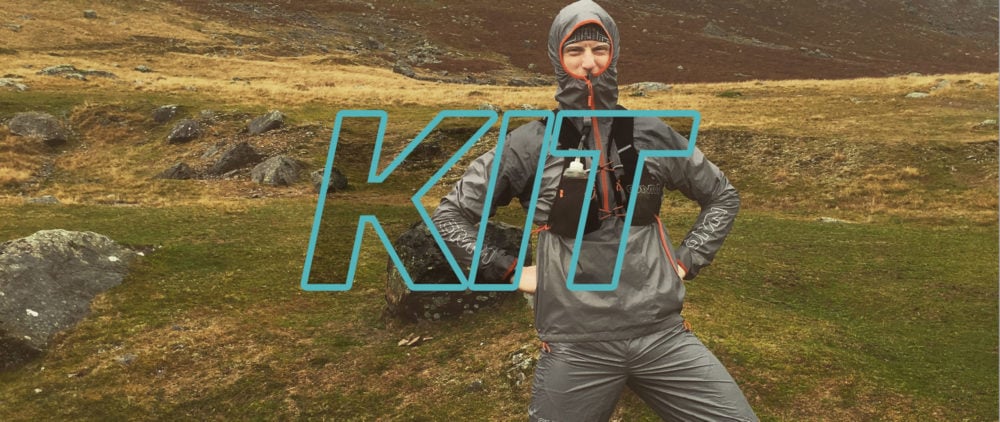
This all leads us (so neatly, its almost like we planned it!) to what kit to take. This decision is very personal and a lot of it will come from experience. Expect to take too much the first time you head out and then whittle it down to what you actually need and use (in addition to those just-in-case extras).
A couple of good starting questions when deciding what kit to take are:
How long am I planning on being out?
How long will it take for someone to reach me if it goes wrong?
How badly will this reflect on me when they find my body?
If the answer to the first two is: half an hour and about 5 minutes, then you can probably leave the emergency shelter at home.
But if you are heading far from the road and into the high hills, you need to consider the above questions very carefully.
Here is a great blog from Tim Budd, an MRT member on the subject.
Clothing: As with your route choice, the speed at which you able to move will influence what you will want to wear. Soft snow and high winds will see you moving much slower and so not generating as much heat as when moving quickly but then slogging up a snowy slope can see your temperature rise as you put way more effort than usual into your forward progress.
In winter, the difference between your temperature when moving and when static is most pronounced. A layering system that is perfect while moving quickly could see you dangerously exposed if you had to stop for any reason.
Spare layers are an essential back up in winter mountains but think about which you take. Are you likely to strip to the skin to change your baselayer, even if it is soaked, or is it better to carry additional midlayers that can be added under a shell, in addition to insulation? The weight penalty of carrying an extra midlayer is far outweighed by not getting hypothermic.
Insulating pieces are not normally part of the running arsenal, except when back at the car or overnight camp but in winter; insulation pieces can form an important part of your clothing system. The main choice in insulation is between synthetic or down fill; down is warmest for its weight and pack size but loses its insulating properties when wet; synthetic insulation is more durable than down and keeps its warmth even when wet but is slightly heavier and bulkier. Insulation pieces are often not as breathable as fleece or polyester layers and so you will need to consider this when using them. They are often best kept in the pack until you hit the tops or slow down later in the day.
An exception to this is the new generation of ‘active insulation’ pieces. These act like a traditional insulating jacket but are much more breathable and can be worn while moving without overheating. Check out the Core Range for more info.
It is tempting to layer up at the car, when you are cold and static but as soon as you set off and hit the first uphill, you will rapidly overheat, soaking your baselayer with sweat and will probably need to stop to take off a few layers. The old adages; ‘dress for 15 minutes time’ and ‘be bold, start cold’, really do still hold true.
Baselayers are still an important consideration in winter. Though you may be moving slower over some sections, there are also going to be parts that make you sweat, especially fighting wind and snow. If your baselayer does not wick away sweat or dry quickly, you will soon get cold and wet. Use a quick-drying layer that will respond to a variety of outputs throughout the day.
Even in relatively benign conditions, if there is snow on the ground or it is saturated with winter rain and meltwater, it is likely your socks and gloves are going to get wet and cold. You should always think about carrying spares of both (it is quite normal to head out with 3 pairs of gloves). It may also be worth looking into waterproof socks, though they may not keep you 100% dry, they tend to be much warmer than alternatives. This is also a good time to give mitts a shout out. Keeping all your fingers grouped together means they’ll be a lot warmer than in just gloves. An overmitt allows you to swap and change gloves then cover everything up and keep them warm and dry, leaving fingers free when needed.
See below for our ideal winter layering system along with the rest of our winter kit list.
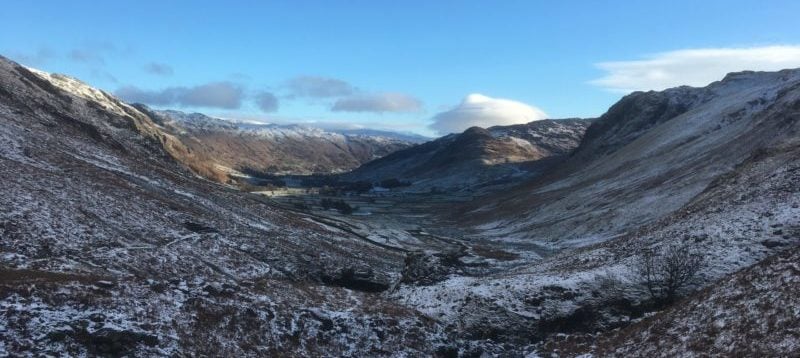
Equipment: Yet again, the conditions will decide what you need to take but you can expect to need a few extra bits to make yourself safe and comfortable. And as ever, any piece of equipment is only as useful as the abilities of the person using it. Below are a few key pieces that can make all the difference, you can find a full winter running kit list at the end.
Poles: Poles are no longer just for your annual ski holiday or for when you have hurt your knee. Once the sole domain of Euro mountain whippets and elderly ramblers, poles are fast becoming a year-round tool for mountain runners. Poles really come into their own in winter. Like having a pair of stabilizers, they give security over uncertain terrain, serve to push you along over slow ground and generally give you something to wave about in photos. If buying pair with a view to winter use, don’t be tempted to look only at weight; consider their strength too. Uber-light racing poles are great for fast and light summer trails but might not take too kindly to being hammered through semi-frozen bog and hauled on up snowy slopes. Look, instead, for strength, weight and pack size. You want to be able to easily stow them when not in use and rely on them when you need them.
Axes: There are a range of super-lightweight axes available on the market, aimed primarily at the ski-touring market but increasingly being taken up by winter and alpine runners looking for a failsafe on snowy slopes. The first thing to say is that just carrying an axe will not keep you safe. You also need to know how to use it. This and myriad other reasons is why we would strongly suggest seeking professional instruction on a winter skills course from a qualified instructor if you are hoping to push yourself over technical terrain in winter. The main reason to carry an ice axe while winter running is to perform an ice axe arrest if you slip on steep ground, they can also provide security on icy stretches; but we are not suggesting you start banging out winter climbing routes in your fell shoes!
Micro-Spikes/Running Crampons: These are lightweight, flexible spikes that can fit most running shoes and provide traction on ice and frozen snow. There are several different designs available, from so-called postman crampons which are little more than studs on a rubber backer, more suited to icy tarmac and pavements, to coils of metal that run across the bottom of the shoe and give good traction on compacted snow and icy paths, right up to flexible crampons with multiple metal spikes that allow you to run or walk over quite steep frozen ground. Again, as with the axe, a crampon is only as good as your ability to use it and they certainly have their limits, especially on a flexible running shoe. Learn how to use them and learn their limits in a safe environment. Don’t expect to be running Tower Ridge any time soon (even if Finlay Wild can)!
Snow/Ski Goggles: These can be invaluable in high winds when spindrift can leave you all but blind. They weigh very little and make you look hardcore plus you can read a map without your eyeballs freezing.
Headtorch: Winter means days are shorter and you will likely be out for longer; this adds up to you probably needing some lighting at some point! Keep your batteries charged (carry spares too) and always have a torch in your pack. Looking through rescue reports from any of the country’s Search & Rescue teams and you will see call out after call out that could have been avoided just by carrying a decent headtorch.
It is worth mentioning at this point the effect the cold can have on electronics. Headtorches and mobile phone battery life can be drastically reduced by the cold. Keep any electronics or spare batteries close to your body in an inside pocket. Plus, rechargeables tend to have a shorter burn time than disposables but disposables kill baby turtles so…swings and roundabouts.
Emergency Shelter/Bivi Bag: If it all goes wrong or you just want to get out of the wind to eat your lunch, an emergency shelter will make life a lot better.
You can go for either a multi-person shelter otherwise known as a ‘Bothy Bag’ which is a bit bigger but provides easy access to shelter for you and your partner/s. Or go for a foil bivvy bag or Blizzard bag. These reflect your body heat back at you and are more of an emergency option. Remember, you may not need it yourself but you may come across someone who does. Go for a bag not a blanket because a blanket will just blow away and then you’ll die.
Gas: This isn’t a winter camping article but it is worth noting, if you are planning on taking brew making kit or doing an overnight, bear in mind some gas blends are better than others in cold weather. Make sure you get a specific Winter Mix.
The OMM Recommended Kit List For A Fairly Big Day Out In The Hills* (or OMMRKLFAFBDOITH for short)
Clothing:
Fell or good trail shoe (half a size bigger than normal will allow for thicker socks)
Long Waterproof Socks (plus spare normal pair)
Full length Legging
Waterpoof or windproof shorts (trust us, they make a big difference!)
Overtrousers
Long Sleeve Wicking Tee
Short Sleeve Wicking Tee
Lightweight Midlayer (plus spare)
Insulated jacket or vest
Waterproof Shell (Consider going for something heavier duty than your normal summer shell as you are likely to have rain, sleet and snow pushing against you in high winds. Thin fabrics can then be pressed to the skin or layers underneath and have a cooling effect)
Lightweight Gloves or Mitts (plus spares)
Overmitt (tied to you)
Buff (x2, one for the neck and one for head or down front of leggings if you didn’t bother with the windproof shorts!)
Hat/Beanie (plus spare)
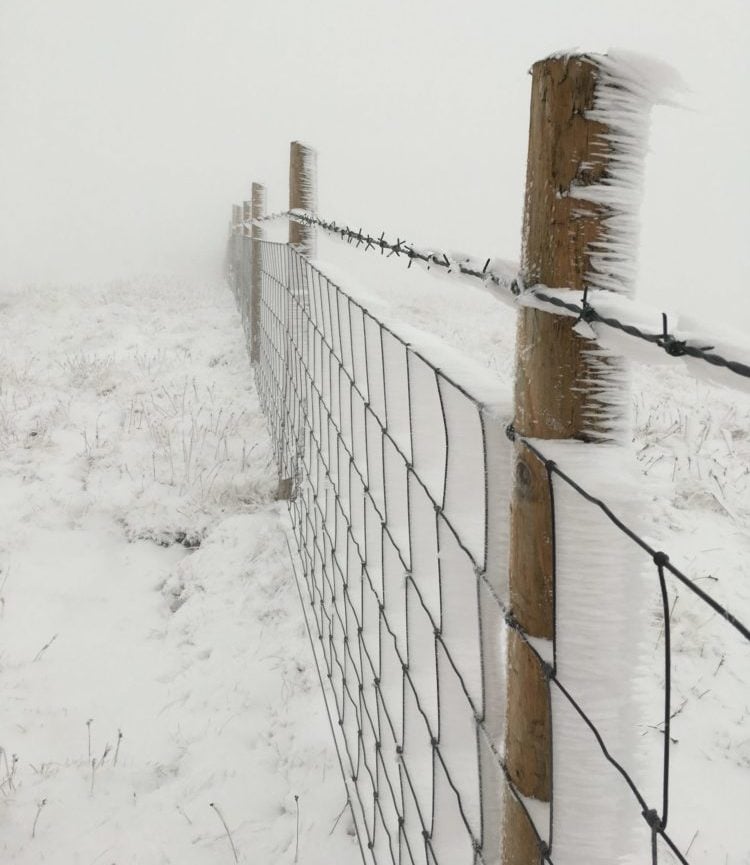
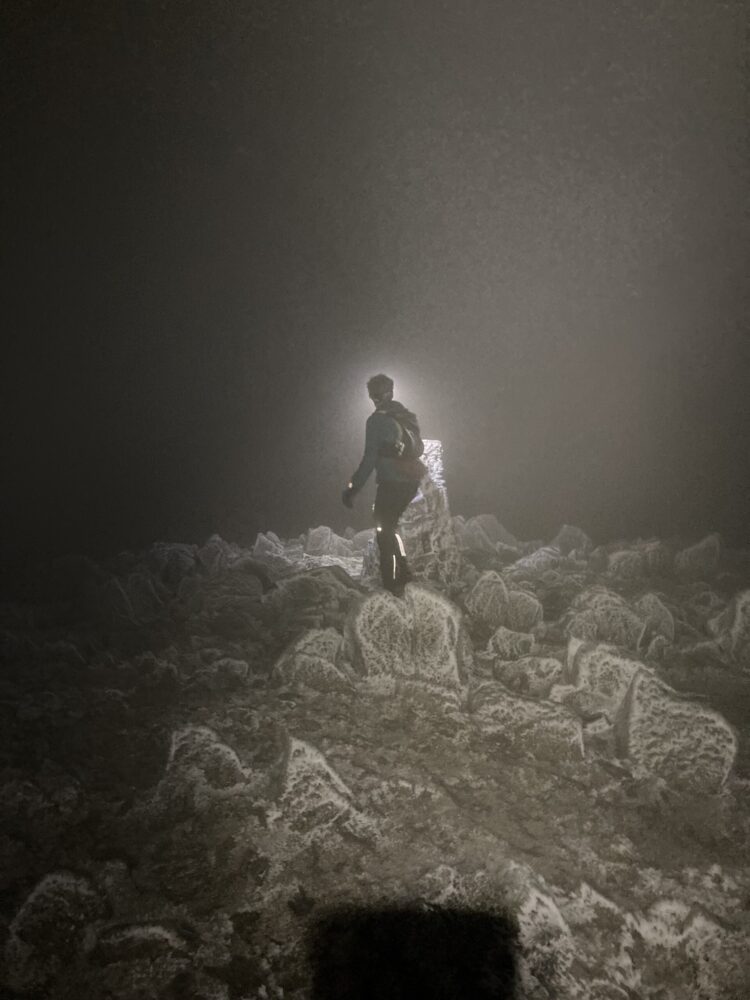
Consider investing in some form of running crampon if spending extended periods on ice or frozen snow
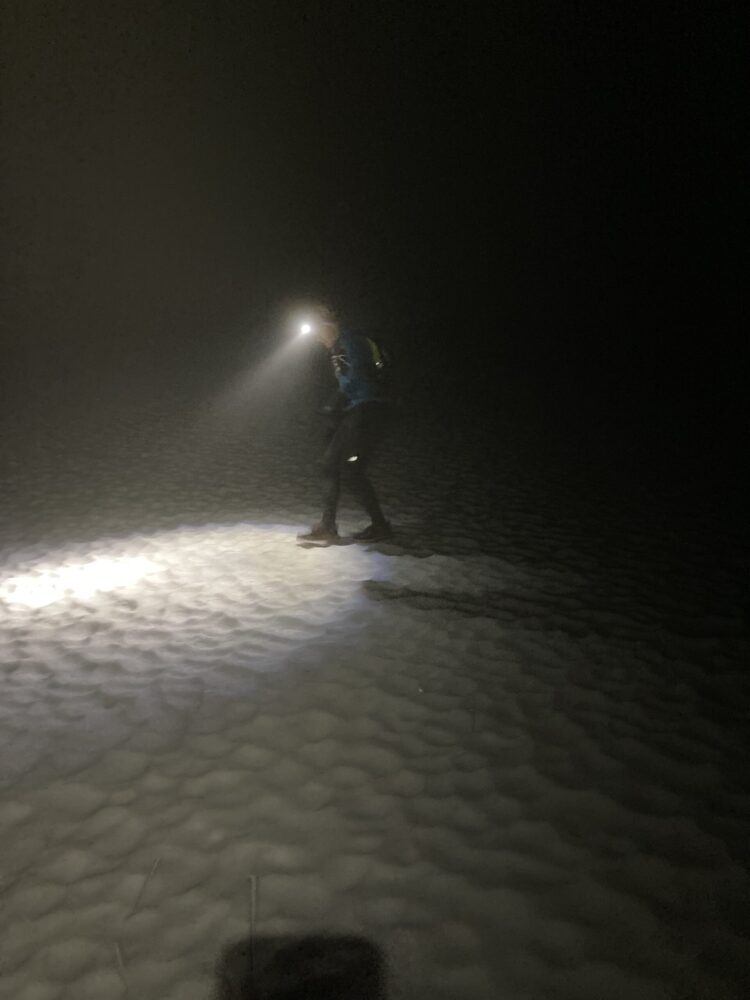
You can expect to spend at least some of your long winter runs in the dark
Equipment:
Poles (pair)
Microspikes
Axe (and the knowledge of how to use it) if doing something steep/technical
Goggles
Foil Bivvy bag
Map (in case, tied to you)
Compass (tied to you)
GPS as back up
Mobile phone for epic selfies (and registered to the Emergency SMS Service – just text register to 999 and follow the instructions. In a dry bag, close to the body)
Headtorch (plus spare batteries in an inside pocket & possibly back–up smaller headtorch)
Food for the day (plus spare)
Water bottles
Small flask of hot fluid (optional but very nice!)
Dry bags
Rucksack big enough to carry it all
Route card left with a responsible adult
*Not to say this is comprehensive or that you have to carry every single bit but these are all bits of kit that we have found to be useful over the years and that we think are worth considering.
